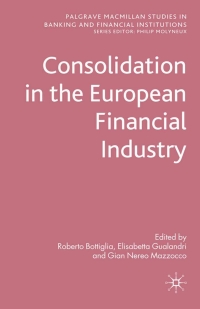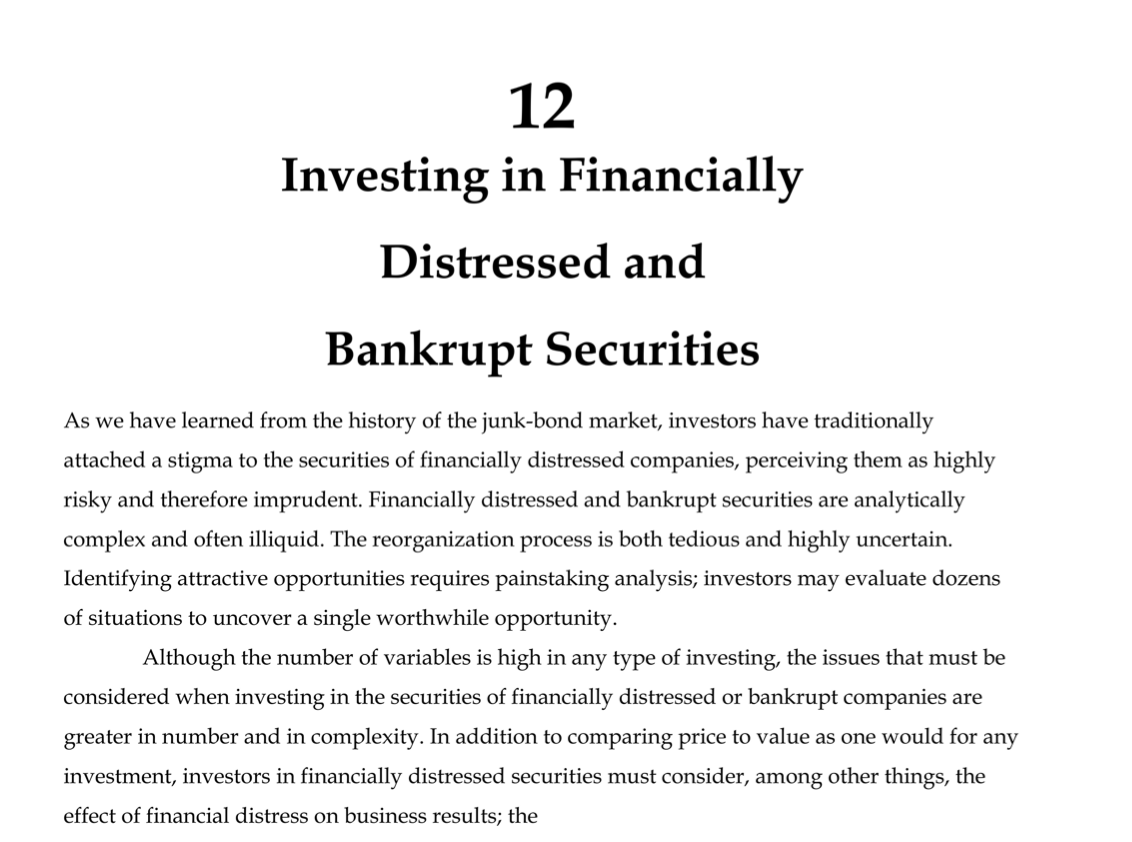
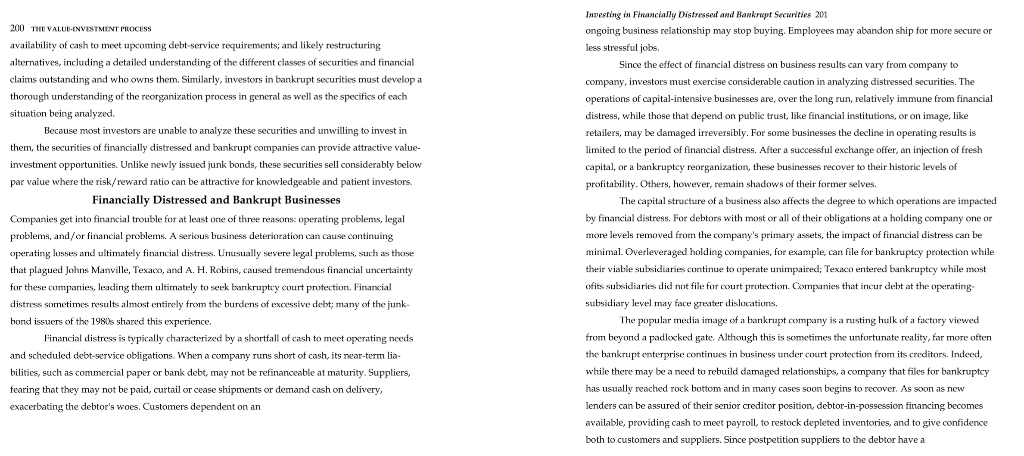

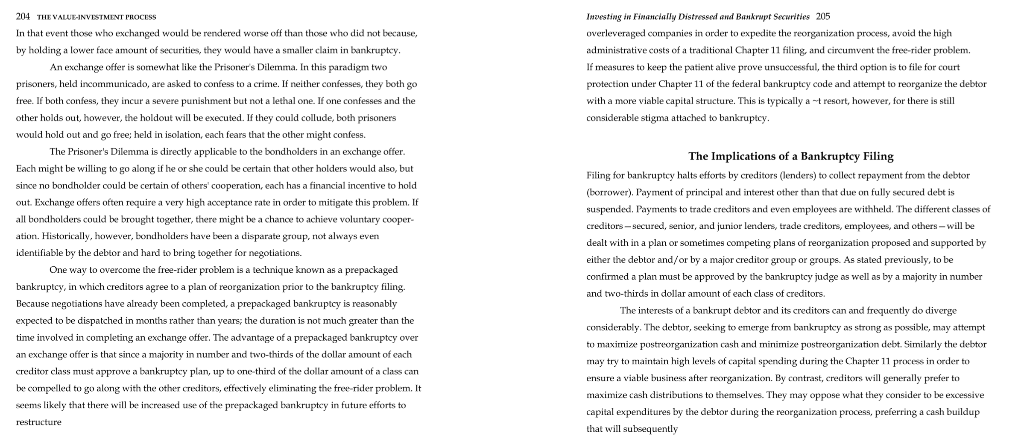
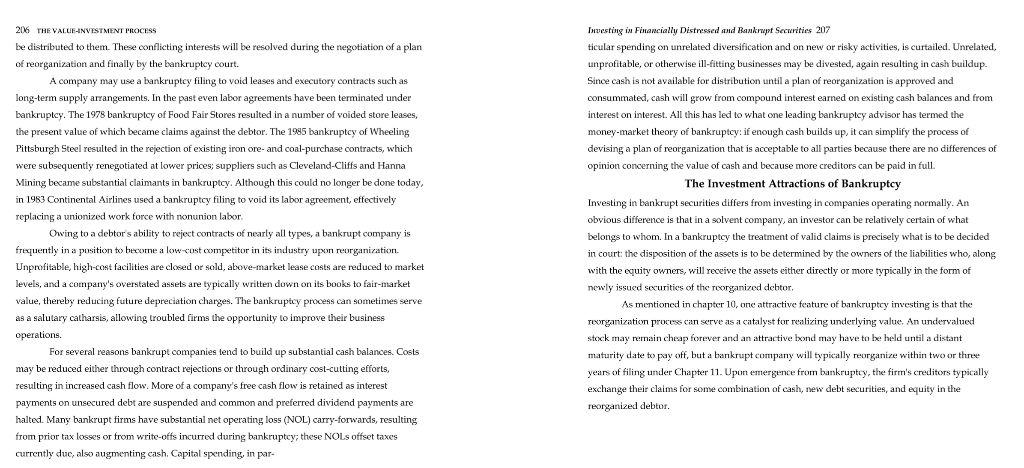
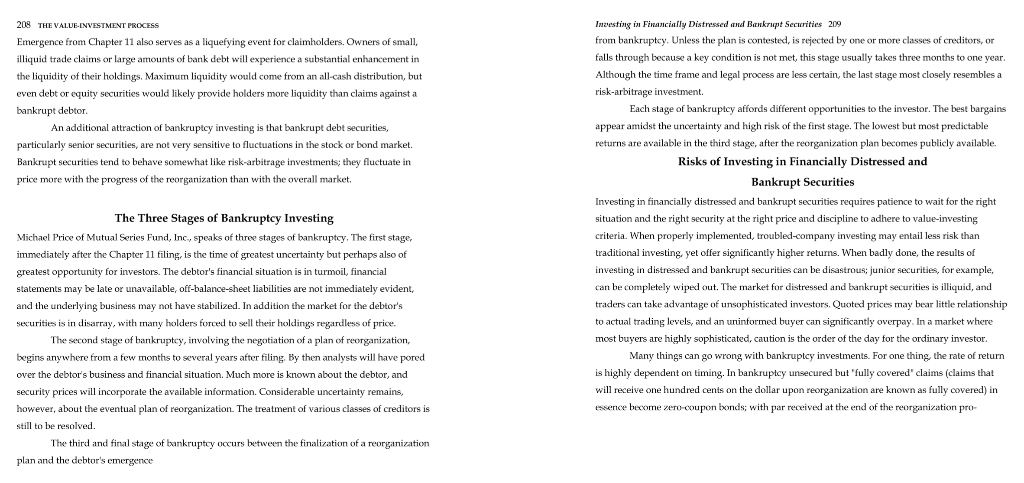
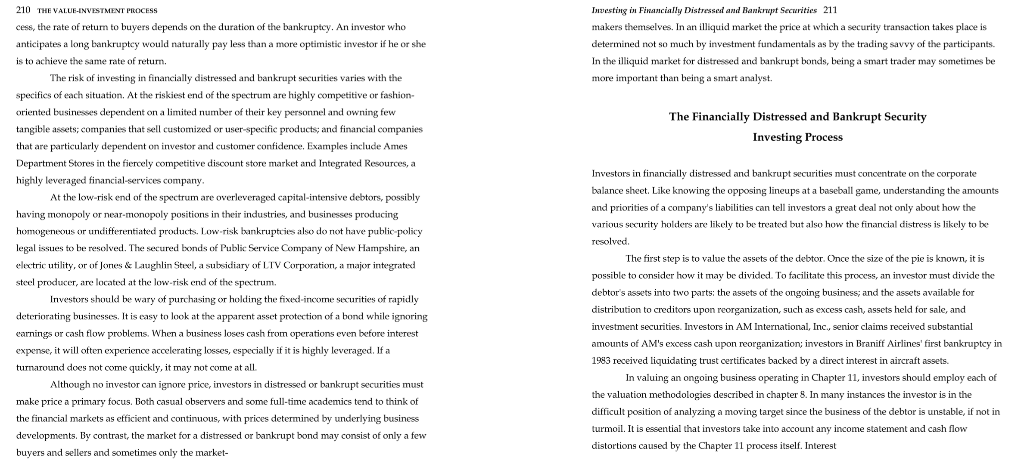
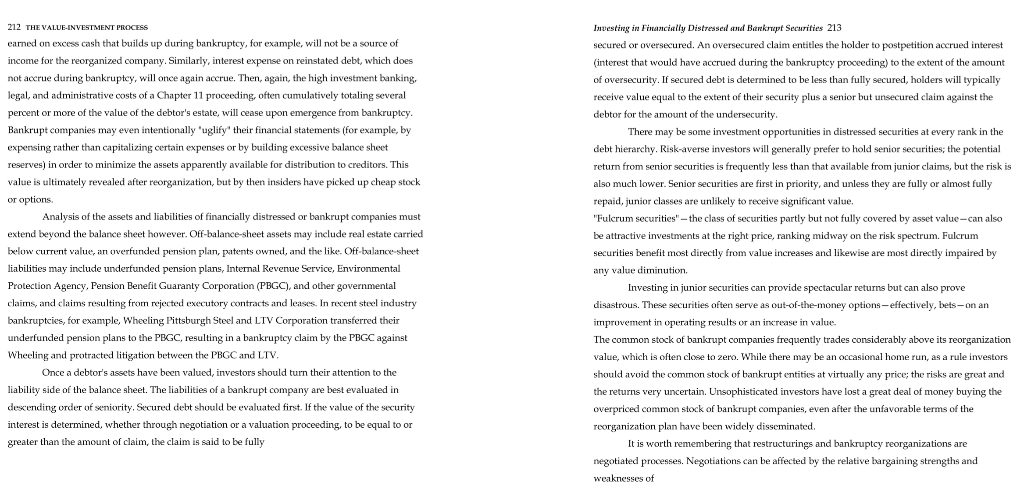
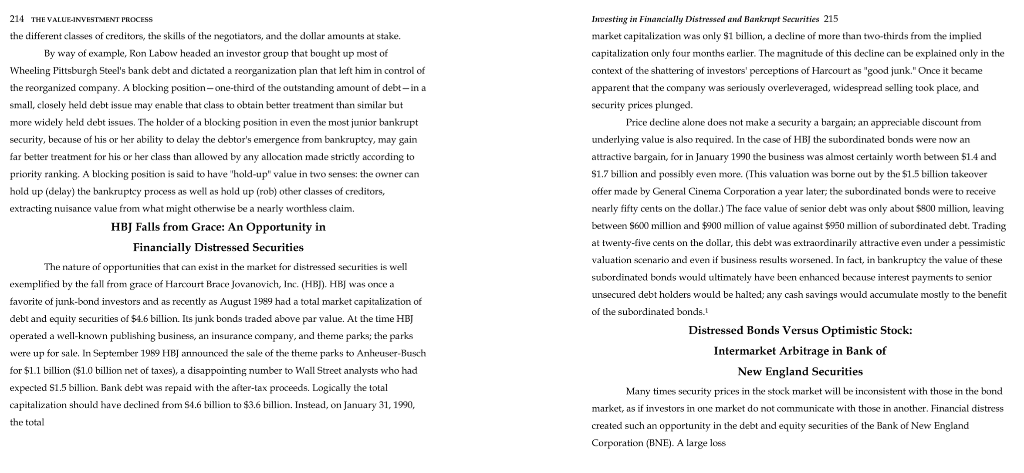
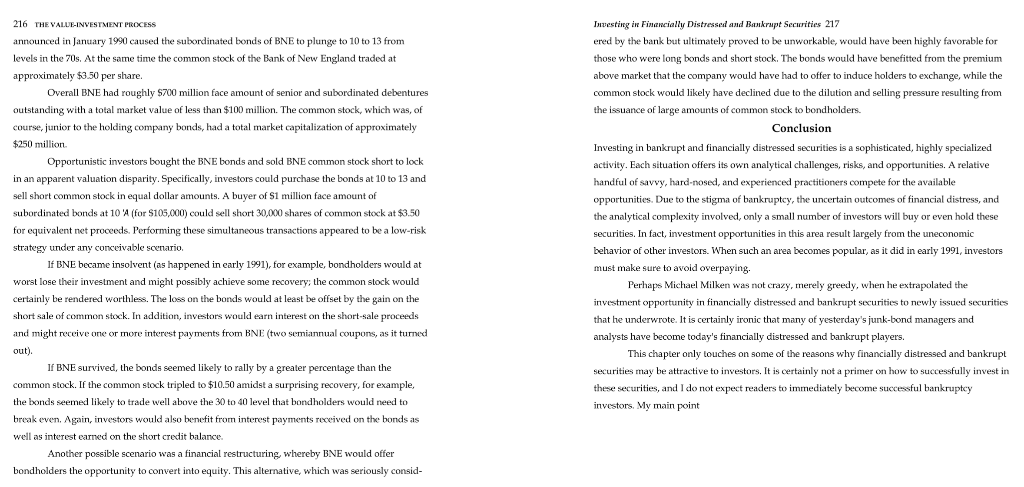
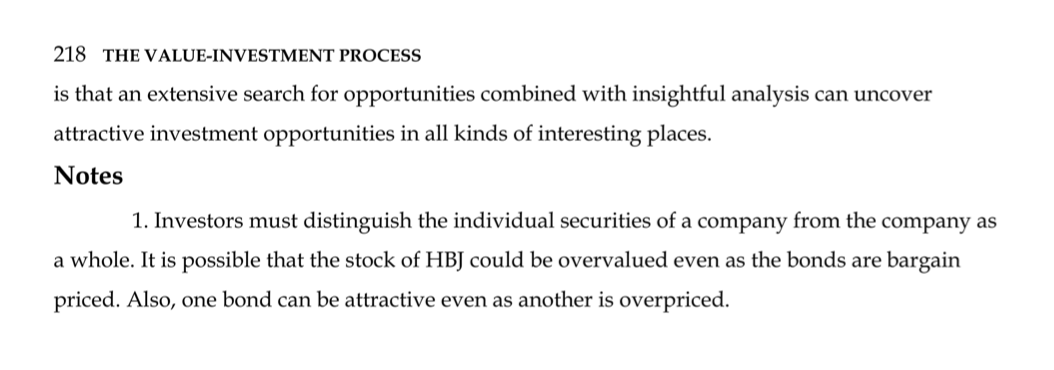

12 Investing in Financially Distressed and Bankrupt Securities As we have learned from the history of the junk-bond market, investors have traditionally attached a stigma to the securities of financially distressed companies, perceiving them as highly risky and therefore imprudent. Financially distressed and bankrupt securities are analytically complex and often illiquid. The reorganization process is both tedious and highly uncertain. Identifying attractive opportunities requires painstaking analysis; investors may evaluate dozens of situations to uncover a single worthwhile opportunity. Although the number of variables is high in any type of investing, the issues that must be considered when investing in the securities of financially distressed or bankrupt companies are greater in number and in complexity. In addition to comparing price to value as one would for any investment, investors in financially distressed securities must consider, among other things, the effect of financial distress on business results; the 200 THE VALUE-INVESTMENT PROCESS availability of cash to meet upcoming debt-service requirements; and likely restructuring alternatives, including a detailed understanding of the different classes of securities and financial claims outstanding and who owns them. Similarly, investors in bankrupt securities must develop a thorough understanding of the reorganization process in general as well as the specifics of each situation being analyzed. Because most investors are unable to analyze these securities and unwilling to invest in them, the securities of financially distressed and bankrupt companies can provide attractive value- investment opportunities. Unlike newly issued junk bonds, these securities sell considerably below par value where the risk/reward ratio can be attractive for knowledgeable and patient investors. Financially Distressed and Bankrupt Businesses Companies get into financial trouble for at least one of three reasons: operating problems, legal problems, and/or financial problems. A serious business deterioration can cause continuing operating losses and ultimately financial distres. Unusually severe legal problems, such as those that plagued Johns Manville, Texaco, and A. H. Robins, caused tremendous financial uncertainty for these companies, leading them ultimately to seek bankruptcy court protection. Financial distress sometimes results almost entirely from the burdens of excessive debt; many of the junk- hond issuers of the 1980s shared this experience. Financial distress is typically characterized by a shortfall of cash to meet operating needs and scheduled debt-service obligations. When a company runs short of cash, its near-term lia- bilities, such as commercial paper or bank debt, may not be refinanceable at maturity. Suppliers, fearing that they may not be paid, curtail or cease shipments or demand cash on delivery, exacerbating the debtor's woes. Customers dependent on an Investing in Financially Distressed and Bankrupt Securities 201 ongoing business relationship may stop buying, Employees may abandon ship for more secure or less stressful jobs. Since the effect of financial distress on business results can y from company to company, investors must exercise considerable caution in analyzing distressed securities. The operations of capital-intensive businesses are over the long run, relatively immune from financial distress, while those that depend on public trust, like financial institutions, or on image, like retailers, may be damaged irreversibly. For some businesses the decline in operating results is limited to the period of financial distress. After a successful exchange offer, an injection of fresh capital, or a bankruptcy reorganization, these businesses recover to their historic levels of profitability. Others, however, remain shadows of their former selves. The capital structure of a business also affects the degree to which operations are impacted by financial distress. For debtors with most or all of their obligations at a holding company one or more levels removed from the company's primary assets, the impact of financial distress can be minimal. Overleveraged holding companies, for example, can file for bankruptcy protection while their viable subsidiaries continue to operate unimpaired; Texaco entered bankruptcy while most ofits subsidiaries did not file for court protection. Companies that incur debt at the operating- subsidiary level may face greater dislocations, The popular media image of a bankrupt company is a rusting hulk of a factory viewed from beyond a padlocked gate. Although this is sometimes the unfortunate reality, far more often the bankrupt enterprise continues business under court protection from its creditors. Indeed, while there may be a need to rebuild damaged relationships, a company that files for bankruptcy has usually reached rock bottom and in many cases soon begins to recover. As soon as new lenders can be assured of their senior creditor position, debtor-in-possession financing becomes available, providing cash to meet payroll, to restock depleted inventories, and to give confidence both to customers and suppliers. Since postpetition suppliers to the debtor have a 202 THE VALUE INVESTMENT PROCESS senior claim to unsecured prepetition creditors, most suppliers renew shipments. As restocked inventories and increased confidence stimulate business and as deferred maintenance and delayed capital expenditures are undertaken, results may begin to improve. Cash usually starts to build (for a number of reasons to be discussed later). When necessary, new management can be attracted by the prospect of a stable and improving business situation and by the lure of low-priced stock or options in the reorganized company. While Chapter 11 is not a panacea, bankruptcy can provide a sheltered opportunity for some troubled businesses to return to financial health. Issuer Responses to Financial Distress There are three principal alternatives for an issuer of debt securities that encounters financial distress: continue to pay principal and interest when due, offer to exchange new securities for securities currently outstanding, or default and file for bankruptcy. A potential investor in distressed securities must consider each of these three possible scenarios before committing capital Financially troubled companies can try to survive outside bankruptcy by resorting to cost cutting, asset sales, or an infusion of outside capital. Such efforts can be successful, depending on the precise cause of the debtor's woes. Short-term palliatives, however, can contribute to the erosion of long term business value. Efforts to conserve cash by cutting back inventory, stretching out accounts payable, or reducing salaries, for example, can get a business through a short-term crisis, but in the long run some of these measures may hurt relationships with customers, suppliers, and employees and result in a diminution of business value. A second option for a company is to make an exchange offer to replace outstanding debt and, where relevant, preferred stock with new securities. The possibility of an exchange offer adds a Investing in Financially Distressed awl Bankrupt Securities 203 strategic dimension to investing in financially distressed securities absent from most passive investments. An exchange offer is an attempt by a financially distressed issuer to stave off bankruptcy by offering new, less-onerous securities in exchange for some or all of those outstanding. An exchange offer can serve as an out-of-court plan of reorganization. Sometimes an offer is made to exchange for only one security, perhaps the issuer needs only to extend an upcoming maturity Other times most or all outstanding debt securities and, where relevant, preferred stock are offered the opportunity to exchange. Exchange offers are difficult to complete. Typically they involve persuading debt holders (and preferred stockholders, if any) to accept less than one dollar's worth of new securities for each current dollar of claim against the debtor. The greatest difficulty in consummating an exchange offer is that, unlike stockholders, bondholders cannot be compelled to do anything. Depending on state law, a vote of 50 percent or 67 percent of the stockholders of a company is sufficient to approve a merger; the minority is compelled to go along. However, the majority of a class of bondholders cannot force the minority to accept an exchange offer. This results in a free-rider problem since the value of "holding out" is typically greater than the value of going along with a restructuring Suppose Company X needs to cut its debt from $100 million to $75 million and offers bondholders an opportunity to exchange their bonds, currently trading at fifty cents on the dollar, for new bonds of equal seniority valued at seventy-five. This offer may be acceptable to each holder; individually they would be willing to forego the full value of their claims in order to avoid the uncertainty and the delay of bankruptcy proceedings as well as the loss of the time-value of their money. They may be concerned, however, that if they agree to exchange while others do not, they will have sacrificed 25 percent of the value owed them when others have held out for full value. Morcover, if they make the sacrifice and others do not, the debtor may not be sufficiently benefitted and could fail anyway Investing in Financially Distressed and Bankrupt Securities 205 overleveraged companies in order to expedite the reorganization process, avoid the high administrative costs of a traditional Chapter 11 filing, and circumvent the free-rider problem. If measures to keep the patient alive prove unsuccessful, the third option is to file for court protection under Chapter 11 of the federal bankruptcy code and attempt to reorganize the debtor with a more viable capital structure. This is typically at resort, however, for there is still considerable stigma attached to bankruptcy. 204 THE VALUE INVESTMINT PROCESS In that event those who exchanged would be rendered worse off than those who did not because, by holding a lower face amount of securities, they would have a smaller claim in bankruptcy, An exchange offer is somewhat like the Prisoner's Dilemma. In this paradigm two prisoners, held incommunicado, are asked to confess to a crime. If neither confesses, they both go free. If both confess, they incur a severe punishment but not a lethal one. If one confesses and the other holds out, however, the holdout will be executed. If they could collude, both prisoners would hold out and go free; held in isolation, each fears that the other might confess. The Prisoner's Dilemma is directly applicable to the bondholders in an exchange offer. Each might be willing to go along if he or she could be certain that other holders would also, but since no bondholder could certain of others' cooperation, each has a financial incentive to hold out. Exchange offers often require a very high acceptance rate in order to mitigate this problem. If all bondholders could be brought together, there might be a chance to achieve voluntary cooper- ation. Historically, however, bondholders have been a disparate group, not always even identifiable by the debtor and hard to bring together for negotiations. One way to overcome the free-rider problem is a technique known as a prepackaged bankruptcy, in which creditors agree to a plan of reorganization prior to the bankruptcy filing. Because negotiations have already been completed, a prepackaged bankruptcy is reasonably expected to be dispatched in montis rather than years; the duration is not much greater than the time involved in completing an exchange ofter. The advantage of a prepackaged bankruptcy over an exchange offer is that since a majority in number and two-thirds of the dollar amount of each creditor class must approve a bankruptcy plan, up to one-third of the dollar amount of a class can be compelled to go along with the other creditors, effectively eliminating the free-rider problem. It seems likely that there will be increased use of the prepackaged bankruptcy in future efforts to restructure The Implications of a Bankruptcy Filing Filing for bankruptcy halts efforts by creditors (lenders) to collect repayment from the debtor (borrower), Payment of principal and interest other than that due on fully secured debt is suspended. Payments to trade creditors and even employees are withheld. The different classes of creditors-secured, senior, and junior lenders, trade creditors, employees, and others will be dealt with in a plan or sometimes competing plans of reorganization proposed and supported by either the debtor and/or by a major creditor group or groups. As slated previously, to be confirmed a plan must be approved by the bankruptcy judge as well as by a majority in number and two-thirds in dollar amount of each class of creditors. The interests of a bankrupt debtor and its creditors can and frequently do diverge considerably, The debtor, seeking to emerge from bankruptcy as strong as possible, may attempt to maximize postreorganization cash and minimize postreorganization debt. Similarly the debtor may try to maintain high levels of capital spending during the Chapter 11 process in order to ensure a viable business after reorganization. By contrast, creditors will generally prefer to maximize cash distributions to themselves. They may oppose what they consider to be excessive capital expenditures by the debtor during the reorganization process, preferring a cash buildup that will subsequently 206 THE VALUE-INVESTMENT PROCESS be distributed to them. These conflicting interests will be resolved during the negotiation of a plan of reorganization and finally by the bankruptcy court. A company may use a bankruptcy filing to void leases and executory contracts such as long-term supply arrangements. In the past even labor agreements have been terminated under bankruptcy. The 1978 bankruptcy of Food Fair Stores resulted in a number of voided store leases, the present value of which became claims against the debtor. The 1985 bankruptcy of Wheeling Pittsburgh Steel resulted in the rejection of existing iron ore-and coal-purchase contracts, which were subsequently renegotiated at lower prices, suppliers such as Cleveland Cliffs and Hanna Mining became substantial claimants in bankruptcy. Although this could no longer be done today, in 1983 Continental Airlines used a bankruptcy filing to void its labor agreement, effectively replacing a unionized work force with nonunion labor. Owing to a debtor's ability to reject contracts of nearly types, a bankrupt company is frequently in a position to become a low-cost competitor in its industry upon reorganization. Unprofitable, high-cost facilities are closed or sold, above-market lease costs are reduced to market levels, and a company's overstated assets are typically written down on its books to fair-market value, thereby reducing future depreciation charges. The bankruptcy process can sometimes serve as a salutary catharsis, allowing troubled firms the opportunity to improve their business operations. For several reasons bankrupt companies tend to build up substantial cash balances. Costs may be reduced either through contract rejections or through ordinary cost-cutting efforts, resulting in increased cash flow. More of a company's free cash flow is retained as interest payments on unsecured debt are suspended and common and preferred dividend payments are halted. Many bankrupt firms have substantial net operating loss (NOL) carry-forwards, resulting from prior tax losses or from write-offs incurred during bankruptcy; these NOLs offset taxes currently due, also augmenting cash. Capital spending, in par- Investing in Financially Distressed and Bankrupt Securities 207 ticular spending on unrelated diversification and on new or risky activities, is curtailed. Unrelated, unprofitable, or otherwise ill-fitting businesses may be divested, again resulting in cash buildup. Since cash is not available for distribution until a plan of reorganization is approved and consummated, cash will grow from compound interest earned on existing cash balances and from interest on interest. All this has led to what one leading bankruptcy advisor has termed the money-market theory of bankruptcy: if enough cash builds up, it can simplify the process of devising a plan of reorganization that is acceptable to all parties because there are no differences of opinion concerning the value of cash and because more creditors can be paid in full. The Investment Attractions of Bankruptcy Investing in bankrupt securities differs from investing in companies operating normally. An obvious difference is that in a solvent company, an investor can be relatively certain of what belongs to whom. In a bankruptcy the treatment of valid claims is precisely what is to be decided in court: the disposition of the assets is to be determined by the owners of the liabilities who, along with the equity owners, will receive the assets either directly or more typically in the form of newly issued securities of the reorganized debtor. As mentioned in chapter 10, one attractive feature of bankruptcy investing is that the reorganization process can serve as a catalyst for realizing underlying value. An undervalued stock may remain cheap forever and an attractive bond may have to be held until a distant maturity date to pay off, but a bankrupt company will typically reorganize within two or three years of filing under Chapter 11. Upon emergence from bankruptcy, the firm's creditors typically exchange their claims for some combination of cash, new debt securities, and equity in the Teorganized debtor 208 THE VALUE-INVESTMENT PROCESS Emergence from Chapter 11 also serves as a liquefying event for claimholders. Owners of small, illiquid trade claims or large amounts of bank debt will experience a substantial enhancement in the liquidity of their holdings, Maximum liquidity would come from an all-cash distribution, but even debt or equity securities would likely provide holders more liquidity than claims against a bankrupt debtor. An additional attraction of bankruptcy investing is that bankrupt debt securities, particularly senior securities, are not very sensitive to fluctuations in the stock or bond market. Bankrupt securities tend to behave somewhat like risk-arbitrage investments; they fluctuate in price more with the progress of the reorganization than with the overall market, The Three Stages of Bankruptcy Investing Michael Price of Mutual Series Fund, Inc, speaks of three stages of bankruptcy. The first stage, immediately after the Chapter 11 filing, is the time of greatest uncertainty but perhaps also of greatest opportunity for investors. The debtor's financial situation is in turmoil, financial statements may be late or unavailable, off-balance sheet liabilities are not immediately evident, and the underlying business may not have stabilized. In addition the market for the debtor's securities is in disarray, with many holders forced to sell their holdings regardless of price. The second stage of bankruptey, involving the negotiation of a plan of reorganization, begins anywhere from a few months to several years after filing. By then analysts will have pored over the debtor's business and financial situation. Much more is known about the debtor, and security prices will incorporate the available information. Considerable uncertainty remains, however, about the eventual plan of reorganization. The treatment of various classes of creditors is still to be resolved. The third and final stage of bankruptcy occurs between the finalization of a reorganization plan and the debtor's emergence Investing in Financially Distressed and Bankrupt Securities 209 from bankruptcy. Unless the plan is contested, is rejected by one or more classes of creditors, or falls through because a key condition is not met, this stage usually takes three months to one year. Although the time frame and legal process are less certain, the last stage most closely resembles a risk-arbitrage investment. Each stage of bankruptcy affords different opportunities to the investor. The best bargains appear amidst the uncertainty and high risk of the first stage. The lowest but most predictable returns are available in the third stage after the reorganization plan becomes publicly available. Risks of Investing in Financially Distressed and Bankrupt Securities Investing in financially distressed and bankrupt securities requires patience to wait for the right situation and the right security at the right price and discipline to adhere to value-investing criteria. When properly implemented, troubled-company investing may entail less risk than traditional investing, yet offer significantly higher returns. When badly done, the results of investing in distressed and bankrupt securities can be disastrous, junior securities, for example, can be completely wiped out. The market for distressed and bankrupt securities is illiquid, and traders can take advantage of unsophisticated investors. Quoted prices may bear little relationship to actual trading levels, and an uninformed buyer can significantly overpay. In a market where most buyers are highly sophisticated, caution is the order of the day for the ordinary investor Many things can go wrong with bankruptcy investments. For one thing the rate of return is highly dependent on timing. In bankruptcy unsecured but 'fully covered' claims (claims that will receive one hundred cents on the dollar upon reorganization are known as fully covered) in essence become vero-coupon bonds with par received at the end of the reorganization pro Investing in Financially Distressed and Bankrupt Securities 211 makers themselves. In an illiquid market the price at which a security transaction takes place is determined not so much by investment fundamentals as by the trading savvy of the participants. In the illiquid market for distressed and bankrupt bonds, being a smart trader may sometimes be more important than being a smart analyst. The Financially Distressed and Bankrupt Security Investing Process 210 THE VALUE INVESTMENT PROCESS cess, the rate of return to buyers depends on the duration of the bankruptcy. An investor who anticipates a long bankruptcy would naturally pay less than a more optimistic investor if he or she is to achieve the same rate of retum. The risk of investing in financially distressed and bankrupt securities varies with the specifics of each situation. At the riskiest end of the spectrum are highly competitive or fashion- oriented businesses dependent on a limited number of their key personnel and owning few tangible assets, companies that sell customized or user-specific products; and financial companies that are particularly dependent on investor and customer confidence, Examples include Ames Department Stores in the fiercely competitive discount store market and Integrated Resources, a highly leveraged financial services company At the low-risk end of the spectrum are overleveraged capital-intensive debtors, possibly having monopoly or near-monopoly positions in their industries, and businesses producing homogeneous r undifferentiated products. Low-risk bankruptcies also do not have public policy legal issues to be resolved. The secured bonds of Public Service Company of New Hampshire, an clextric utility, or of Jones & Laughlin Steel, a subsidiary of LTV Corporation, a major integrated steel producer, are located at the low-risk end of the spectrum Investors should be wary of purchasing or holding the fixed-income securities of rapidly deteriorating businesses. It is easy to look at the apparent asset protection of a bond while ignoring earnings or cash flow problems. When a business loses cash from operations even before interest expense, it will often experience accelerating losses, especially if it is highly leveraged. If a turnaround does not come quickly, it may not come at all. Although no investor can ignore price, investors in distressed or bankrupt securities must make price a primary focus. Both casual observers and some full-time academics tend to think of the financial markets as efficient and continuous, with prices determined by underlying business developments. By contrast, the market for a distressed bankrupt bond may consist of only a few buyers and sellers and sometimes only the market- Investors financially distressed and bankrupt securities must concentrate on the corporate balance sheet. Like knowing the opposing lineups at a baseball game, understanding the amounts and priorities of a company's liabilities can tell investors a great deal not only about how the various security holders are likely to be treated but also how the financial distress is likely to be resolved The first step is to value the assets of the debtor. Once the size of the pie is known, it is possible to consider how it may be divided. To facilitate this process, an investor must divide the debtor's assets into two parts: the assets of the ongoing business; and the assets available for distribution to creditors upon reorganization, such as excess cash, assets held for sale, and investment securities. Investors in AM International, Inc., senior claims received substantial amounts of AM's excess cash upon reorganization; investors in Braniff Airlines' first bankruptcy in 1983 received liquidating trust certificates backed by a direct interest in aircraft assets. In valuing an ongoing business operating in Chapter 11, investors should employ each of the valuation methodologies described in chapter 8. In many instances the investor is in the difficult position of analyzing a moving target since the business of the debtor is unstable, if not in turmoil. It is essential that investors take into account any income statement and cash flow distortions caused by the Chapter process itself. Interest 212 THE VALUE-INVESTMENT PROCESS earned on excess cash that builds up during bankruptcy, for example, will not be a source of income for the reorganized company, Similarly, interest expense reinstated debt, which does not accrue during bankruptcy, will once again accrue. Then again, the high investment banking, legal, and administrative costs of a Chapter 11 proceeding, often cumulatively totaling several percent or more of the value of the debtor's estate, will cease upon emergence from bankruptcy. Bankrupt companies may even intentionally 'uglify their financial statements (for example, by expensing rather than capitalizing certain expenses or by building excessive balance sheet reserves) in order to minimize the assets apparently available for distribution to creditors. This value is ultimately revealed after reorganization, but by then insiders have picked up cheap stock or options Analysis of the assets and liabilities of financially distressed or bankrupt companies must extend beyond the balance sheet however. Off-balance sheet assets may include real estate carried below current value, an overfunded pension plan, patents owned, and the like. Off-balance-sheet liabilities may include underfunded pension plans, Internal Revenue Service, Environmental Protection Agency, Pension Benefit Guaranty Corporation (PBGC), and other governmental claims and claims resulting from rejected executory contracts and leases. In recent steel industry bankruptcies, for example, Wheeling Pittsburgh Steel and LTV Corporation transferred their underfunded pension plans to the PBGC, resulting in a bankruptcy claim by the PBGC against Wheeling and protracted litigation between the PBGC and LTV. Once a debtor's assets have been valued, investors should turn their attention to the liability side of the balance sheet. The liabilities of a bankrupt company are best evaluated in descending order seniority, Secured debt should be evaluated first. If the value of the security interest is determined, whether through negotiation or a valuation proceeding, to be equal to or greater than the amount of claim, the claim is said to be fully Investing in Financially Distressed and Bankrupt Securities 213 secured or oversecured. An oversecured claim entitles the holder to postpetition accrued interest (interest that would have accrued during the bankruptcy proceeding) to the extent of the amount of oversecurity. If secured debt is determined to be less than fully secured, holders will typically receive value equal to the extent of their security plus a senior but unsecured claim against the debtor for the amount of the undersecurity There may be some investment opportunities in distressed securities at every rank in the debt hierarchy. Risk-averse investors will generally prefer to hold senior securities; the potential return from senior securities is frequently less than that available from junior claims, but the risk is also much lower. Senior securities are first in priority, and unless they are fully or almost fully repaid, junior classes are unlikely to receive significant value. "Fulcrum securities"- the class of securities partly but not fully covered by asset value-can also be attractive investments at the right price, ranking midway on the risk spectrum. Fulcrum securities benefit most directly from value increases and likewise are most directly impaired by any value diminution. Investing in junior securities can provide spectacular returns but can also prove disastrous. These securities often serve as out-of-the-money options-effectively, bets-on an improvement in operating results or an increase in value. The common stock of bankrupt companies frequently trades considerably above its reorganization value, which is often close to zero. While there may be an occasional home run, as a rule investors should avoid the common stock of bankrupt entities at virtually any price; the risks are great and the returns very uncertain. Unsophisticated investors have lost a great deal of money buying the overpriced common stock of bankrupt companies, even after the unfavorable terms of the reorganization plan have been widely disseminated. It is worth remembering that restructurings and bankruptcy reorganizations are negotiated processes. Negotiations can be affected by the relative bargaining strengths and weaknesses of 214 THE VALUE-INVESTMENT PROCESS the different classes of creditors, the skills of the negotiators, and the dollar amounts at stake. By way of example, Ron Labow headed an investor group that bought up most of Wheeling Pittsburgh Steel's bank debt and dictated a reorganization plan that left him in control of the reorganized company. A blocking position-one-third of the outstanding amount of debt, in a small, closely held debt issue may enable that class to obtain better treatment than similar but more widely held debt issues. The holder of a blocking position in even the most junior bankrupt security, because of his or her ability to delay the debtor's emergence from bankruptcy, may gain far better treatment for his or her class than allowed by any allocation made strictly according to priority ranking. A blocking position is said to have "hold-up" value in two senses: the owner can hold up (delay) the bankruptcy process as well as hold up (rob) other classes of creditors, extracting nuisance value from what might otherwise be a nearly worthless claim. HBJ Falls from Grace: An Opportunity in Financially Distressed Securities The nature of opportunities that can exist in the market for distressed securities is well exemplified by the fall from grace of Harcourt Brace Jovanovich, Inc. (HB). HBJ was once a favorite of junk-bond investors and as recently as August 1989 had a total market capitalization of debt and equity securities of $4.6 billion. Ils junk bonds traded above par value. At the time HEJ operated a well-known publishing business, an insurance company, and theme parks; the parks were up for sale. In September 1989 HBJ announced the sale of the theme parks to Anheuser-Busch for $1.1 billion ($1.0 billion net of taxes), a disappointing number to Wall Street analysts who had expected S1.5 billion. Bank debt was repaid with the after-tax proceeds. Logically the total capitalization should have declined from $4.6 billion to $3.6 billion. Instead, on January 31, 1990, the total Investing in Financially Distressed and Bankrupt Securities 215 market capitalization was only $1 billion, a decline of more than two-thirds from the implied capitalization only four months earlier. The magnitude of this decline can be explained only in the context of the shattering of investors' perceptions of Harcourt as "good junk."Once it became apparent that the company was seriously overleveraged, widespread selling took place, and security prices plunged. Price decline alone does not make a security a bargain; an appreciable discount from underlying value is also required. In the case of HBJ the subordinated bonds were now an attractive bargain, for in January 1990 the business was almost certainly worth between $1.4 and 51.7 billion and possibly even more. (This valuation was borne out by the $1.5 billion takeover offer made by General Cinema Corporation a year later; the subordinated bonds were to receive nearly fifty cents on the dollar.) The face value of senior debt was only about $800 million, leaving between S600 million and $900 million of value against $950 million of subordinated debt. Trading at twenty-five cents on the dollar, this debut was extraordinarily attractive even under a pessimistic valuation scenario and even if business results worsened. In fact, in bankruptcy the value of these subordinated bonds would ultimately have been enhanced because interest payments to senior unsecured debt holders would be halted; any cash savings would accumulate mostly to the benefit of the subordinated bonds. Distressed Bonds Versus Optimistic Stock: Intermarket Arbitrage in Bank of New England Securities Many times security prices in the stock market will be inconsistent with those in the bond market, as if investors in one market do not communicate with those in another. Financial distress created such an opportunity in the debt and equity securities of the Bank of New England Corporation (BNE). A large loss 216 THE VALUE-INVESTMENT PROCESS announced in January 1990 caused the subordinated bonds of BNE to plunge to 10 to 13 from levels in the 70s. At the same time the common stock of the Bank of New England traded at approximately $3.50 per share. Overall BNE had roughly $700 million face amount of senior and subordinated debentures outstanding with a total market value of less than $100 million. The common stock, which was, of course, junior to the holding company bonds, had a total market capitalization of approximately $250 million. Opportunistic investors bought the BNE bonds and sold BNE common stock short to lock in an apparent valuation disparity. Specifically, investors could purchase the bonds at 10 to 13 and sell short common stock in equal dollar amounts. A buyer of $1 million face amount of subordinated bonds at 10 'A (for $105,000) could sell short 30,000 shares of common stock at $3.50 for equivalent net proceeds. Performing these simultaneous transactions appeared to be a low-risk strategy under any conceivable scenario. If BNE became insolvent (as happened in early 1991), for example, bondholders would at worst lose their investment and might possibly achieve some recovery; the common stock would certainly be rendered worthless. The loss on the bonds would at least be offset by the gain on the short sale of common stock. In addition, investors would earn interest on the short-sale proceeds and might receive one or more interest payments from BNE (two semiannual coupons, as it turned out). If BNE survived, the bonds seemed likely to rally by a greater percentage than the common stock. If the common stock tripled to $10.50 amidst a surprising recovery, for example, the bonds seemed likely to trade well above the 30 to 40 level that bondholders would need to break even. Again, investors would also benefit from interest payments received on the bonds as well as interest earned on the short credit balance. Another possible scenario was a financial restructuring, whereby BNE would offer bondholders the opportunity to convert into equity. This alternative, which was seriously consid- Investing in Financially Distressed and Bankrupt Securities 217 ered by the bank but ultimately proved to be unworkable, would have been highly favorable for those who were long bonds and short stock. The bonds would have benefitted from the premium above market that the company would have had to offer to induce holders to exchange, while the common stock would likely have declined due to the dilution and selling pressure resulting from the issuance of large amounts of common stock to bondholders. Conclusion Investing in bankrupt and financially distressed securities is a sophisticated, highly specialized activity. Each situation offers its own analytical challenges, risks, and opportunities. A relative handful of savvy, hard-nosed, and experienced practitioners compete for the available opportunities. Due to the stigma of bankruptcy, the uncertain outcomes of financial distress, and the analytical complexity involved, only a small number of investors will buy or even hold these securities. n fact, investment opportunities in this area result largely from the uneconomic behavior of other investors. When such an area becomes popular, as it did in early 1991, investors must make sure to avoid overpaying. Perhaps Michael Milken was not crazy, merely greedy, when he extrapolated the investment opportunity in financially distressed and bankrupt securities to newly issued securities that he underwrote. It is certainly ironic that many of yesterday's junk-bond managers and analysts have become today's financially distressed and bankrupt players. This chapter only touches on some of the reasons why financially distressed and bankrupt securities may be attractive to investors. It is certainly not a primer on how to successfully invest in these securities, and I do not expect readers to immediately become successful bankruptcy investors. My main point 218 THE VALUE-INVESTMENT PROCESS is that an extensive search for opportunities combined with insightful analysis can uncover attractive investment opportunities in all kinds of interesting places. Notes 1. Investors must distinguish the individual securities of a company from the company as a whole. It is possible that the stock of HBJ could be overvalued even as the bonds are bargain priced. Also, one bond can be attractive even as another is overpriced. Read Chapter 12: "Investing in Financially Distressed and Bankrupt Securities from the book Margin of Safety: Risk-Averse Value Investing Strategies for the Thoughtful Investor Book written by Seth Klarman, one of the most famous value investors. This is a highly appreciated book, and it is out of print. If you are curious, just check in Amazon for how much this book is being sold and answers the following questions: 1) Why the author says that securities of financially distressed and bankrupt companies can provide attractive value investment opportunities? 2) Which are the options that financially troubled companies have to try to survive outside bankruptcy? 3) What is the Prisoner's Dilemma?| 4) Why the author said that a bankrupt company is frequently in a position to become a low-cost competitor in its industry upon reorganization? 5) Describe some of the risks that an investor might encounter investing in a financially troubled company? 6) After reading the chapter, please share your thoughts about investing in bankrupt companies, will you invest on them? Why? If you invest in them, which approach will you take: purchase stock, senior bonds, junior bonds? And why? 12 Investing in Financially Distressed and Bankrupt Securities As we have learned from the history of the junk-bond market, investors have traditionally attached a stigma to the securities of financially distressed companies, perceiving them as highly risky and therefore imprudent. Financially distressed and bankrupt securities are analytically complex and often illiquid. The reorganization process is both tedious and highly uncertain. Identifying attractive opportunities requires painstaking analysis; investors may evaluate dozens of situations to uncover a single worthwhile opportunity. Although the number of variables is high in any type of investing, the issues that must be considered when investing in the securities of financially distressed or bankrupt companies are greater in number and in complexity. In addition to comparing price to value as one would for any investment, investors in financially distressed securities must consider, among other things, the effect of financial distress on business results; the 200 THE VALUE-INVESTMENT PROCESS availability of cash to meet upcoming debt-service requirements; and likely restructuring alternatives, including a detailed understanding of the different classes of securities and financial claims outstanding and who owns them. Similarly, investors in bankrupt securities must develop a thorough understanding of the reorganization process in general as well as the specifics of each situation being analyzed. Because most investors are unable to analyze these securities and unwilling to invest in them, the securities of financially distressed and bankrupt companies can provide attractive value- investment opportunities. Unlike newly issued junk bonds, these securities sell considerably below par value where the risk/reward ratio can be attractive for knowledgeable and patient investors. Financially Distressed and Bankrupt Businesses Companies get into financial trouble for at least one of three reasons: operating problems, legal problems, and/or financial problems. A serious business deterioration can cause continuing operating losses and ultimately financial distres. Unusually severe legal problems, such as those that plagued Johns Manville, Texaco, and A. H. Robins, caused tremendous financial uncertainty for these companies, leading them ultimately to seek bankruptcy court protection. Financial distress sometimes results almost entirely from the burdens of excessive debt; many of the junk- hond issuers of the 1980s shared this experience. Financial distress is typically characterized by a shortfall of cash to meet operating needs and scheduled debt-service obligations. When a company runs short of cash, its near-term lia- bilities, such as commercial paper or bank debt, may not be refinanceable at maturity. Suppliers, fearing that they may not be paid, curtail or cease shipments or demand cash on delivery, exacerbating the debtor's woes. Customers dependent on an Investing in Financially Distressed and Bankrupt Securities 201 ongoing business relationship may stop buying, Employees may abandon ship for more secure or less stressful jobs. Since the effect of financial distress on business results can y from company to company, investors must exercise considerable caution in analyzing distressed securities. The operations of capital-intensive businesses are over the long run, relatively immune from financial distress, while those that depend on public trust, like financial institutions, or on image, like retailers, may be damaged irreversibly. For some businesses the decline in operating results is limited to the period of financial distress. After a successful exchange offer, an injection of fresh capital, or a bankruptcy reorganization, these businesses recover to their historic levels of profitability. Others, however, remain shadows of their former selves. The capital structure of a business also affects the degree to which operations are impacted by financial distress. For debtors with most or all of their obligations at a holding company one or more levels removed from the company's primary assets, the impact of financial distress can be minimal. Overleveraged holding companies, for example, can file for bankruptcy protection while their viable subsidiaries continue to operate unimpaired; Texaco entered bankruptcy while most ofits subsidiaries did not file for court protection. Companies that incur debt at the operating- subsidiary level may face greater dislocations, The popular media image of a bankrupt company is a rusting hulk of a factory viewed from beyond a padlocked gate. Although this is sometimes the unfortunate reality, far more often the bankrupt enterprise continues business under court protection from its creditors. Indeed, while there may be a need to rebuild damaged relationships, a company that files for bankruptcy has usually reached rock bottom and in many cases soon begins to recover. As soon as new lenders can be assured of their senior creditor position, debtor-in-possession financing becomes available, providing cash to meet payroll, to restock depleted inventories, and to give confidence both to customers and suppliers. Since postpetition suppliers to the debtor have a 202 THE VALUE INVESTMENT PROCESS senior claim to unsecured prepetition creditors, most suppliers renew shipments. As restocked inventories and increased confidence stimulate business and as deferred maintenance and delayed capital expenditures are undertaken, results may begin to improve. Cash usually starts to build (for a number of reasons to be discussed later). When necessary, new management can be attracted by the prospect of a stable and improving business situation and by the lure of low-priced stock or options in the reorganized company. While Chapter 11 is not a panacea, bankruptcy can provide a sheltered opportunity for some troubled businesses to return to financial health. Issuer Responses to Financial Distress There are three principal alternatives for an issuer of debt securities that encounters financial distress: continue to pay principal and interest when due, offer to exchange new securities for securities currently outstanding, or default and file for bankruptcy. A potential investor in distressed securities must consider each of these three possible scenarios before committing capital Financially troubled companies can try to survive outside bankruptcy by resorting to cost cutting, asset sales, or an infusion of outside capital. Such efforts can be successful, depending on the precise cause of the debtor's woes. Short-term palliatives, however, can contribute to the erosion of long term business value. Efforts to conserve cash by cutting back inventory, stretching out accounts payable, or reducing salaries, for example, can get a business through a short-term crisis, but in the long run some of these measures may hurt relationships with customers, suppliers, and employees and result in a diminution of business value. A second option for a company is to make an exchange offer to replace outstanding debt and, where relevant, preferred stock with new securities. The possibility of an exchange offer adds a Investing in Financially Distressed awl Bankrupt Securities 203 strategic dimension to investing in financially distressed securities absent from most passive investments. An exchange offer is an attempt by a financially distressed issuer to stave off bankruptcy by offering new, less-onerous securities in exchange for some or all of those outstanding. An exchange offer can serve as an out-of-court plan of reorganization. Sometimes an offer is made to exchange for only one security, perhaps the issuer needs only to extend an upcoming maturity Other times most or all outstanding debt securities and, where relevant, preferred stock are offered the opportunity to exchange. Exchange offers are difficult to complete. Typically they involve persuading debt holders (and preferred stockholders, if any) to accept less than one dollar's worth of new securities for each current dollar of claim against the debtor. The greatest difficulty in consummating an exchange offer is that, unlike stockholders, bondholders cannot be compelled to do anything. Depending on state law, a vote of 50 percent or 67 percent of the stockholders of a company is sufficient to approve a merger; the minority is compelled to go along. However, the majority of a class of bondholders cannot force the minority to accept an exchange offer. This results in a free-rider problem since the value of "holding out" is typically greater than the value of going along with a restructuring Suppose Company X needs to cut its debt from $100 million to $75 million and offers bondholders an opportunity to exchange their bonds, currently trading at fifty cents on the dollar, for new bonds of equal seniority valued at seventy-five. This offer may be acceptable to each holder; individually they would be willing to forego the full value of their claims in order to avoid the uncertainty and the delay of bankruptcy proceedings as well as the loss of the time-value of their money. They may be concerned, however, that if they agree to exchange while others do not, they will have sacrificed 25 percent of the value owed them when others have held out for full value. Morcover, if they make the sacrifice and others do not, the debtor may not be sufficiently benefitted and could fail anyway Investing in Financially Distressed and Bankrupt Securities 205 overleveraged companies in order to expedite the reorganization process, avoid the high administrative costs of a traditional Chapter 11 filing, and circumvent the free-rider problem. If measures to keep the patient alive prove unsuccessful, the third option is to file for court protection under Chapter 11 of the federal bankruptcy code and attempt to reorganize the debtor with a more viable capital structure. This is typically at resort, however, for there is still considerable stigma attached to bankruptcy. 204 THE VALUE INVESTMINT PROCESS In that event those who exchanged would be rendered worse off than those who did not because, by holding a lower face amount of securities, they would have a smaller claim in bankruptcy, An exchange offer is somewhat like the Prisoner's Dilemma. In this paradigm two prisoners, held incommunicado, are asked to confess to a crime. If neither confesses, they both go free. If both confess, they incur a severe punishment but not a lethal one. If one confesses and the other holds out, however, the holdout will be executed. If they could collude, both prisoners would hold out and go free; held in isolation, each fears that the other might confess. The Prisoner's Dilemma is directly applicable to the bondholders in an exchange offer. Each might be willing to go along if he or she could be certain that other holders would also, but since no bondholder could certain of others' cooperation, each has a financial incentive to hold out. Exchange offers often require a very high acceptance rate in order to mitigate this problem. If all bondholders could be brought together, there might be a chance to achieve voluntary cooper- ation. Historically, however, bondholders have been a disparate group, not always even identifiable by the debtor and hard to bring together for negotiations. One way to overcome the free-rider problem is a technique known as a prepackaged bankruptcy, in which creditors agree to a plan of reorganization prior to the bankruptcy filing. Because negotiations have already been completed, a prepackaged bankruptcy is reasonably expected to be dispatched in montis rather than years; the duration is not much greater than the time involved in completing an exchange ofter. The advantage of a prepackaged bankruptcy over an exchange offer is that since a majority in number and two-thirds of the dollar amount of each creditor class must approve a bankruptcy plan, up to one-third of the dollar amount of a class can be compelled to go along with the other creditors, effectively eliminating the free-rider problem. It seems likely that there will be increased use of the prepackaged bankruptcy in future efforts to restructure The Implications of a Bankruptcy Filing Filing for bankruptcy halts efforts by creditors (lenders) to collect repayment from the debtor (borrower), Payment of principal and interest other than that due on fully secured debt is suspended. Payments to trade creditors and even employees are withheld. The different classes of creditors-secured, senior, and junior lenders, trade creditors, employees, and others will be dealt with in a plan or sometimes competing plans of reorganization proposed and supported by either the debtor and/or by a major creditor group or groups. As slated previously, to be confirmed a plan must be approved by the bankruptcy judge as well as by a majority in number and two-thirds in dollar amount of each class of creditors. The interests of a bankrupt debtor and its creditors can and frequently do diverge considerably, The debtor, seeking to emerge from bankruptcy as strong as possible, may attempt to maximize postreorganization cash and minimize postreorganization debt. Similarly the debtor may try to maintain high levels of capital spending during the Chapter 11 process in order to ensure a viable business after reorganization. By contrast, creditors will generally prefer to maximize cash distributions to themselves. They may oppose what they consider to be excessive capital expenditures by the debtor during the reorganization process, preferring a cash buildup that will subsequently 206 THE VALUE-INVESTMENT PROCESS be distributed to them. These conflicting interests will be resolved during the negotiation of a plan of reorganization and finally by the bankruptcy court. A company may use a bankruptcy filing to void leases and executory contracts such as long-term supply arrangements. In the past even labor agreements have been terminated under bankruptcy. The 1978 bankruptcy of Food Fair Stores resulted in a number of voided store leases, the present value of which became claims against the debtor. The 1985 bankruptcy of Wheeling Pittsburgh Steel resulted in the rejection of existing iron ore-and coal-purchase contracts, which were subsequently renegotiated at lower prices, suppliers such as Cleveland Cliffs and Hanna Mining became substantial claimants in bankruptcy. Although this could no longer be done today, in 1983 Continental Airlines used a bankruptcy filing to void its labor agreement, effectively replacing a unionized work force with nonunion labor. Owing to a debtor's ability to reject contracts of nearly types, a bankrupt company is frequently in a position to become a low-cost competitor in its industry upon reorganization. Unprofitable, high-cost facilities are closed or sold, above-market lease costs are reduced to market levels, and a company's overstated assets are typically written down on its books to fair-market value, thereby reducing future depreciation charges. The bankruptcy process can sometimes serve as a salutary catharsis, allowing troubled firms the opportunity to improve their business operations. For several reasons bankrupt companies tend to build up substantial cash balances. Costs may be reduced either through contract rejections or through ordinary cost-cutting efforts, resulting in increased cash flow. More of a company's free cash flow is retained as interest payments on unsecured debt are suspended and common and preferred dividend payments are halted. Many bankrupt firms have substantial net operating loss (NOL) carry-forwards, resulting from prior tax losses or from write-offs incurred during bankruptcy; these NOLs offset taxes currently due, also augmenting cash. Capital spending, in par- Investing in Financially Distressed and Bankrupt Securities 207 ticular spending on unrelated diversification and on new or risky activities, is curtailed. Unrelated, unprofitable, or otherwise ill-fitting businesses may be divested, again resulting in cash buildup. Since cash is not available for distribution until a plan of reorganization is approved and consummated, cash will grow from compound interest earned on existing cash balances and from interest on interest. All this has led to what one leading bankruptcy advisor has termed the money-market theory of bankruptcy: if enough cash builds up, it can simplify the process of devising a plan of reorganization that is acceptable to all parties because there are no differences of opinion concerning the value of cash and because more creditors can be paid in full. The Investment Attractions of Bankruptcy Investing in bankrupt securities differs from investing in companies operating normally. An obvious difference is that in a solvent company, an investor can be relatively certain of what belongs to whom. In a bankruptcy the treatment of valid claims is precisely what is to be decided in court: the disposition of the assets is to be determined by the owners of the liabilities who, along with the equity owners, will receive the assets either directly or more typically in the form of newly issued securities of the reorganized debtor. As mentioned in chapter 10, one attractive feature of bankruptcy investing is that the reorganization process can serve as a catalyst for realizing underlying value. An undervalued stock may remain cheap forever and an attractive bond may have to be held until a distant maturity date to pay off, but a bankrupt company will typically reorganize within two or three years of filing under Chapter 11. Upon emergence from bankruptcy, the firm's creditors typically exchange their claims for some combination of cash, new debt securities, and equity in the Teorganized debtor 208 THE VALUE-INVESTMENT PROCESS Emergence from Chapter 11 also serves as a liquefying event for claimholders. Owners of small, illiquid trade claims or large amounts of bank debt will experience a substantial enhancement in the liquidity of their holdings, Maximum liquidity would come from an all-cash distribution, but even debt or equity securities would likely provide holders more liquidity than claims against a bankrupt debtor. An additional attraction of bankruptcy investing is that bankrupt debt securities, particularly senior securities, are not very sensitive to fluctuations in the stock or bond market. Bankrupt securities tend to behave somewhat like risk-arbitrage investments; they fluctuate in price more with the progress of the reorganization than with the overall market, The Three Stages of Bankruptcy Investing Michael Price of Mutual Series Fund, Inc, speaks of three stages of bankruptcy. The first stage, immediately after the Chapter 11 filing, is the time of greatest uncertainty but perhaps also of greatest opportunity for investors. The debtor's financial situation is in turmoil, financial statements may be late or unavailable, off-balance sheet liabilities are not immediately evident, and the underlying business may not have stabilized. In addition the market for the debtor's securities is in disarray, with many holders forced to sell their holdings regardless of price. The second stage of bankruptey, involving the negotiation of a plan of reorganization, begins anywhere from a few months to several years after filing. By then analysts will have pored over the debtor's business and financial situation. Much more is known about the debtor, and security prices will incorporate the available information. Considerable uncertainty remains, however, about the eventual plan of reorganization. The treatment of various classes of creditors is still to be resolved. The third and final stage of bankruptcy occurs between the finalization of a reorganization plan and the debtor's emergence Investing in Financially Distressed and Bankrupt Securities 209 from bankruptcy. Unless the plan is contested, is rejected by one or more classes of creditors, or falls through because a key condition is not met, this stage usually takes three months to one year. Although the time frame and legal process are less certain, the last stage most closely resembles a risk-arbitrage investment. Each stage of bankruptcy affords different opportunities to the investor. The best bargains appear amidst the uncertainty and high risk of the first stage. The lowest but most predictable returns are available in the third stage after the reorganization plan becomes publicly available. Risks of Investing in Financially Distressed and Bankrupt Securities Investing in financially distressed and bankrupt securities requires patience to wait for the right situation and the right security at the right price and discipline to adhere to value-investing criteria. When properly implemented, troubled-company investing may entail less risk than traditional investing, yet offer significantly higher returns. When badly done, the results of investing in distressed and bankrupt securities can be disastrous, junior securities, for example, can be completely wiped out. The market for distressed and bankrupt securities is illiquid, and traders can take advantage of unsophisticated investors. Quoted prices may bear little relationship to actual trading levels, and an uninformed buyer can significantly overpay. In a market where most buyers are highly sophisticated, caution is the order of the day for the ordinary investor Many things can go wrong with bankruptcy investments. For one thing the rate of return is highly dependent on timing. In bankruptcy unsecured but 'fully covered' claims (claims that will receive one hundred cents on the dollar upon reorganization are known as fully covered) in essence become vero-coupon bonds with par received at the end of the reorganization pro Investing in Financially Distressed and Bankrupt Securities 211 makers themselves. In an illiquid market the price at which a security transaction takes place is determined not so much by investment fundamentals as by the trading savvy of the participants. In the illiquid market for distressed and bankrupt bonds, being a smart trader may sometimes be more important than being a smart analyst. The Financially Distressed and Bankrupt Security Investing Process 210 THE VALUE INVESTMENT PROCESS cess, the rate of return to buyers depends on the duration of the bankruptcy. An investor who anticipates a long bankruptcy would naturally pay less than a more optimistic investor if he or she is to achieve the same rate of retum. The risk of investing in financially distressed and bankrupt securities varies with the specifics of each situation. At the riskiest end of the spectrum are highly competitive or fashion- oriented businesses dependent on a limited number of their key personnel and owning few tangible assets, companies that sell customized or user-specific products; and financial companies that are particularly dependent on investor and customer confidence, Examples include Ames Department Stores in the fiercely competitive discount store market and Integrated Resources, a highly leverage


















